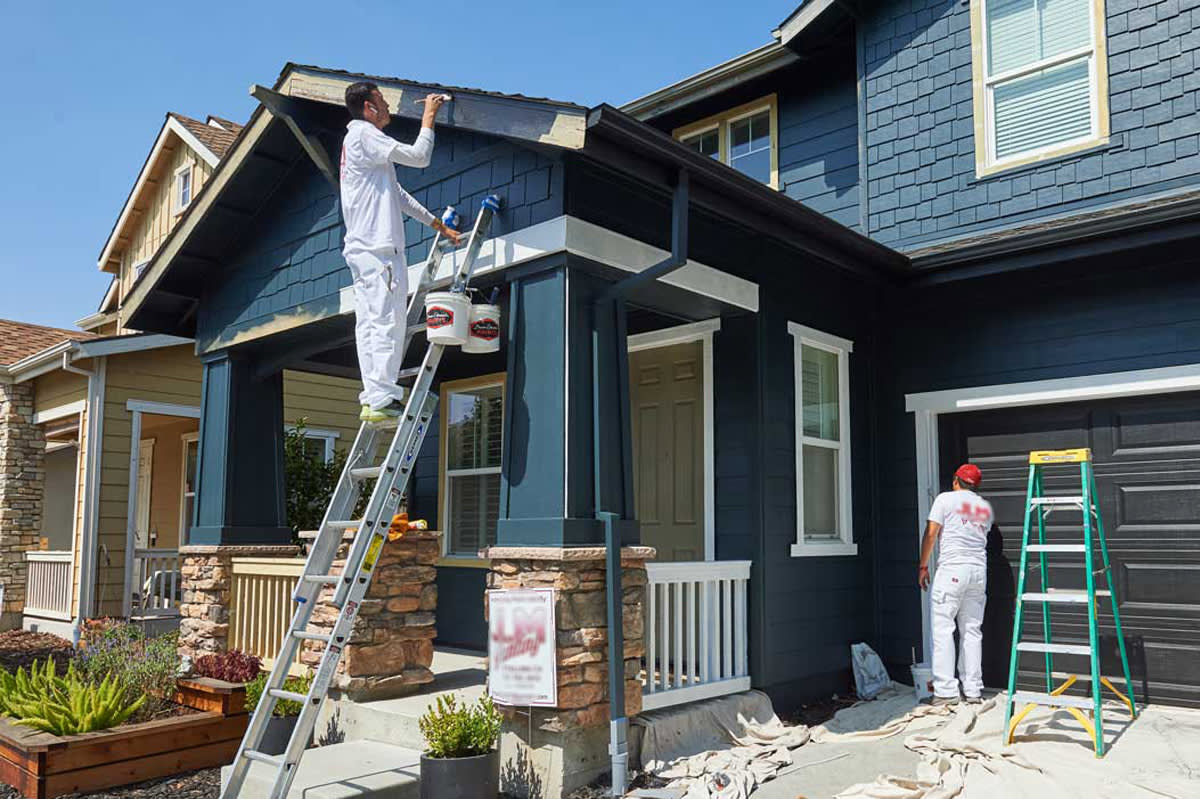Enhance Your Home’s Exterior with premium Paints from paint shops in corpus christi
Discovering the Different Kinds Of Paint: A Guide for Every Job
Checking out the various sorts of paint is necessary for accomplishing the preferred result in any type of project. From water-based alternatives that use comfort to oil-based paints understood for their toughness, each selection has its qualities. Specialty paints can add distinct textures or coatings, while green choices satisfy those seeking sustainability. Understanding these differences can greatly influence the success of a paint venture. What variables should one consider when making the ideal option?
Recognizing Paint Types: Oil-Based vs. water-based
Paint types can markedly affect a job's result, and comprehending the distinctions in between water-based and oil-based paints is important for informed decision-making. Water-based paints, frequently described as latex paints, are made up of water as the primary solvent. They dry rapidly, give off fewer volatile organic compounds (VOCs), and are easy to tidy up with soap and water. This makes them a preferred choice for interior applications and environments where air quality is an issue.
On the other hand, oil-based paints use organic solvents, giving a resilient, glossy coating suitable for surfaces revealed to deterioration, such as trim and cabinets. They take longer to completely dry, call for mineral spirits for clean-up, and have a more powerful smell. corpus christi tx paint shop. Picking in between these 2 kinds depends on the details demands of the job, considering aspects such as wanted coating, application environment, and ease of maintenance. Each type has distinct benefits and restrictions, assisting the selection procedure
The Finish Matters: Choosing Between Matte, Satin, and Gloss
When choosing a paint surface, the choice between matte and shiny choices greatly affects both aesthetic appeals and capability. Matte surfaces offer a refined, non-reflective look that can conceal surface area imperfections, while glossy surfaces provide durability and ease of cleansing. Recognizing the advantages and factors to consider of each can aid in making an educated choice for any kind of paint project.
Matte Complete Benefits
Lots of property owners question the values of numerous surfaces, matte paint supplies unique benefits that make it a popular choice for both indoor and exterior applications. Among the key advantages of matte finish is its capacity to conceal surface flaws, creating a smoother appearance on wall surfaces. This quality is especially advantageous in older homes or rooms with irregular surfaces. In addition, matte paint absorbs light as opposed to showing it, which can improve the aesthetic of a room by offering a much more sophisticated and low-key appearance. Matte surfaces are often simpler to touch up than glossier choices, as they can blend more flawlessly when used over existing paint. On the whole, matte paint is an outstanding option for those seeking a refined and sophisticated surface.
Glossy End Up Factors To Consider
A glossy coating can dramatically alter the perception of an area, supplying a reflective and sleek high quality that boosts both shade vibrancy and light within an area. This surface is often favored for high-traffic locations and surfaces like kitchens and restrooms, where durability and convenience of cleaning are necessary. Its reflective nature can highlight imperfections on walls, making proper surface area prep work essential. Glossy paints additionally tend to reveal spots and fingerprints quicker, necessitating normal maintenance. Furthermore, illumination plays a considerable duty; in bright settings, a shiny surface might develop glare, impacting the total visual. Cautious factor to consider of the details application and atmosphere is vital when selecting a glossy finish for any type of job.
Specialty Paints: When to Use Textured or Chalk Paint
Specialized paints, such as textured and chalk paint, deal unique visual and functional benefits that can enhance different surfaces. Distinctive paint is ideal for creating depth and measurement on wall surfaces, concealing blemishes while adding a three-dimensional feel. It is specifically useful in high-traffic areas where sturdiness and visual interest are essential.

Both kinds of specialized paints can change areas, but choosing the right one depends on the wanted result and surface requirements. Distinctive paint might suit bigger areas, while chalk paint can rejuvenate smaller items, showcasing creativity and individual design in any task.
Outdoor Paints: Safeguarding Your Surfaces From the Aspects
Outdoor paints are important for securing surface areas against different weather. Recognizing their climate resistance features, appropriate surface preparation requirements, and effective application methods can greatly boost resilience and performance. This area will certainly describe vital factors to consider for picking and using outdoor paints properly.
Weather Resistance Features
Weather resistance is an important function of outside paints, as it identifies just how well surface areas can withstand the extreme elements of nature. High-quality exterior paints are created to stand up to damage from UV rays, moisture, and temperature variations. UV resistance assurances colors continue to be dynamic with time, avoiding fading and staining. Moisture resistance shields versus mold and mildew, which can jeopardize the honesty of surface areas. Furthermore, paints with outstanding temperature resistance can increase and contract without fracturing, keeping their protective qualities. When selecting outside paints, it is vital to take right into account these weather resistance functions, as they add to the longevity and durability of painted surface areas, making sure they continue to be aesthetically pleasing and useful in spite of exposure to the aspects.
Surface Area Preparation Needs
Correct surface prep work is a basic step in achieving the ideal results with exterior paints. To guarantee excellent adhesion and durability, surfaces must be completely cleaned up, getting rid of dirt, mold, and oil. This can be completed utilizing a stress washer or a scrub brush with an appropriate cleaning remedy. Once cleansed, surfaces must be inspected for any peeling or flaking paint, which must be scraped away to create a smooth foundation. Repairing any splits or openings is additionally necessary, as these can enable wetness infiltration. Furthermore, fining sand harsh locations promotes better paint attachment. Using a guide fit for outdoor use can enhance the paint's performance, guaranteeing a resilient finish that withstands the components. Correct prep work is vital to a successful outside paint job.
Application Methods Tips
While applying outside paints, it is important to make use of effective methods that guarantee surfaces are well-protected versus the aspects. Initially, choose the appropriate day for painting; low humidity and light temperature levels improve attachment and drying. Prepping the surface area completely-- cleaning, fining sand, and priming-- makes sure better paint attachment and durability. Making use of premium brushes or rollers can provide a smoother coating, while spray paint might cover large locations effectively. Applying paint in slim, even coats avoids runs and drips. It is recommended to adhere to supplier instructions relating to drying out times in between coats. Confirm appropriate air flow throughout application to help with drying and decrease exposure to fumes. These methods significantly enhance the durability and performance of outside paint.
Eco-Friendly Options: Low-VOC and Zero-VOC Paints
As customers end up being increasingly knowledgeable about the ecological impact of their choices, zero-voc and low-voc paints have actually emerged as prominent options. These paints are formulated to contain fewer unpredictable natural compounds (VOCs), which are chemicals that can evaporate right into the air and add to air pollution and health issue. Low-VOC paints typically contain a limited quantity of VOCs, while zero-VOC paints have negligible degrees, making them safer for both indoor and outdoor use.
The benefits of utilizing zero-voc and low-voc paints extend beyond environmental considerations; they likewise enhance interior air quality, minimizing the risk of respiratory concerns and allergies. Lots of suppliers currently supply a variety of shades and finishes in green choices, making it easier for consumers to discover suitable products for their tasks. By selecting these paints, individuals can add to a much healthier environment while still accomplishing the aesthetic they desire in their spaces.
Devices and Strategies for a Perfect Application
Achieving a perfect paint application requires the right devices and techniques, which can considerably improve the result. Selecting the appropriate brush or roller is necessary; brushes function well for sides and complex locations, while rollers cover larger surfaces effectively. Using premium products assures far better paint distribution and decreases streaks. For perfect outcomes, surface area prep work is vital. This consists of cleansing, fining sand, and priming surface areas to promote bond.
Method likewise plays a considerable role. The "W" method with a roller aids to uniformly distribute paint, while long, smooth strokes with a brush avoid visible lines. Working in areas enables far better control and blending. Additionally, using thin layers is more suitable to thick layers, minimizing the danger of drips and irregular textures. Finally, preserving a damp edge throughout application assists achieve seamless modifications in between locations. By integrating these methods and tools, one can achieve a specialist and polished surface.
Tips for Preserving and Taking Care Of Your Painted Surfaces
Proper maintenance and care of coloured surface areas can substantially extend their lifespan and preserve their appearance. Regular cleaning is vital; utilizing a soft towel or sponge with mild soap and water can remove dust and dust without damaging the paint. It is a good idea to avoid abrasive cleaners or rubbing pads, as these can scrape the surface area. In addition, applying a fresh coat of paint every few years can shield and invigorate the color against wear.
For outside surfaces, checking for signs of peeling or fading on a regular basis is necessary. Quickly dealing with any kind of problems stops further damages. In areas prone to moisture, such as shower rooms, making use of mold-resistant paint and guaranteeing proper air flow can assist maintain the honesty of the paint. Finally, using safety coatings can secure against UV rays and spots, making certain that repainted surfaces continue to be dynamic and attractive for years ahead, inevitably enhancing the total visual of the room.
Often Asked Concerns
Can I Mix Different Kind of Paint Together?
Blending click here various kinds of paint is typically not suggested, as it can result in issues like bad attachment, inconsistent structure, or unanticipated chemical responses. It's finest to use suitable paints for optimal outcomes and longevity.

How Do I Effectively Store Leftover Paint?
To properly keep remaining paint, secure the container firmly, tag it with the date and shade, and keep it in a cool, completely dry area away from direct sunlight and extreme temperature levels for suitable preservation.
What Is the most effective Method to Take Care Of Unused Paint?
The finest means to get rid of extra paint is to check neighborhood guidelines, as many locations have marked unsafe waste centers. Additionally, take into consideration donating usable paint to area companies or colleges for their projects.
How Can I Inform if Paint Is Still Good to Use?
To determine if paint is still excellent, examine its uniformity, color, and smell. If it appears separated, has an unpleasant smell, or reveals considerable adjustments in structure, it's most likely no more functional.
Are There Age Restrictions for Investing In Paint Products?
In numerous regions, there are no certain age restrictions for acquiring paint items. Some shops might require clients to be at least 18 years old, specifically for items containing solvents or hazardous products.
Paint kinds can significantly impact a project's end result, and understanding the distinctions between oil-based and water-based paints is crucial for informed decision-making. Water-based paints, often referred to as latex paints, are composed of water as the main solvent. In contrast, oil-based paints make use of natural solvents, offering a resilient, glossy coating ideal for surfaces exposed to wear and tear, such as trim and cabinets. Specialty paints, such as textured and chalk paint, deal distinct aesthetic and useful advantages that can improve various surface areas. In areas vulnerable to moisture, such as restrooms, making use of mold-resistant paint and ensuring appropriate ventilation can assist maintain the honesty of the paint.